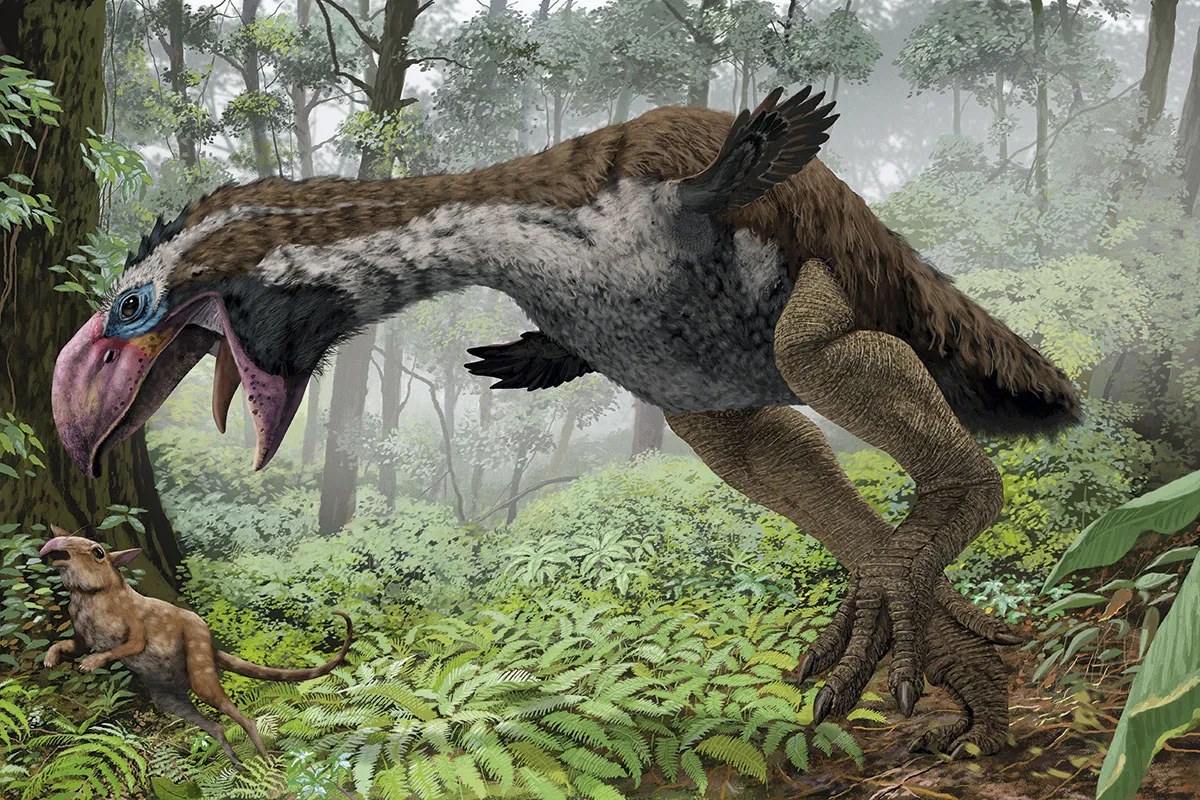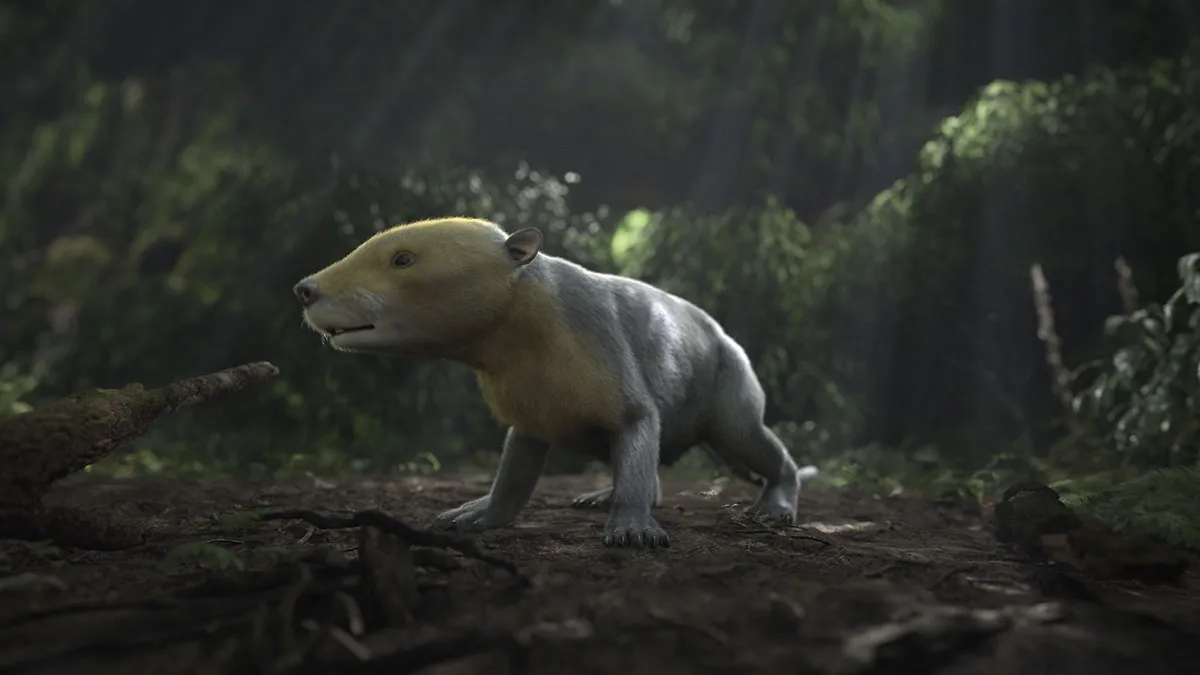During the Triassic, some 225 million years ago, two types of animals went their separate ways. They were both born on the supercontinent of Pangaea, the single slab of land that stretched from the North Pole to the South. Their fates would be different, but forever intertwined. One group was destined for grandeur, and before long, their aeroplane-sized bodies thundered across the land. Dinosaurs. The other group was relegated to the shadows to bide their time. Mammals. Us, our distant ancestors.
Fast-forward some 160 million years, through the Jurassic and to the end of the Cretaceous. Temperatures spiked and crashed, sea levels rose and fell, and the supercontinent became the many continents of today. Through all of this time, dinosaurs and mammals lived together, but followed their own paths.
No mammal ever got larger than a badger, as they were held in check by the dinosaurs. Conversely, the smart and furry little mammals kept dinosaurs from the small-bodied niches, so there never was a miniature T. rex or Triceratops. Like ships passing in the night, the dinosaurs and mammals both diversified, claiming separate realms as their own. Dinosaurs ruled the forests and plains by day, mammals the brush and underground in darkness.
Then, in an instant, everything changed. Sixty-six million years ago, a sudden disaster reshaped the world, and within days, months and years, it upended an evolutionary status quo that had persisted for more than 100,000 millennia. The dinosaurs – except for a few peculiar species with wings and feathers, which became today’s birds – couldn’t cope, and they went extinct. Many mammals felt the pang of death, too, but some managed to endure. From these plucky survivors, the next great dynasty of Earth history would blossom.
Dinosaurs die, mammals survive
With no hint of hyperbole, what happened 66 million years ago was probably the worst single day in the history of our planet.
As herds of Triceratops awoke and began their breakfast of ferns, they had no idea that an asteroid the size of Mount Everest was on a collision course with Earth. It darted through the heavens faster than a gunshot, and by the dumb luck of the cosmos, smashed into what is now the Yucatán Peninsula of Mexico, detonating with the force of over a billion nuclear bombs, punching a hole in the crust over 160 kilometres (100 miles) wide.
Earthquakes ravaged the land and tsunamis sliced up the coasts, the atmosphere turned into an oven, forests spontaneously combusted, pellets of molten rock rained down from the sky. The soot and the grime coagulated in the atmosphere, turning the world dark for many years. Then, in a final insult, the carbon dioxide liberated by the impact superheated the Earth for millennia.

The effects of these immediate, medium-term, and long-term catastrophes was nothing short of an apocalypse. Ecosystems collapsed like houses of cards. Three out of every four species died, making this end-Cretaceous disaster one of the five biggest mass extinctions in Earth history. The most famous victims were all of the non-bird dinosaurs; monsters like T. rex would never stalk the Earth again. Also departing were the pterosaurs (flying reptiles) and the many reptiles, like plesiosaurs and mosasaurs, which swarmed the oceans.
All mass extinctions – at least so far – have had survivors. And this time, they were the mammals. Shockingly, new research shows that mammals nearly went the way of the dinosaurs: only about 7 per cent of species are thought to have made it through the fire and brimstone. Consider a game of asteroid roulette: a gun, with 10 chambers, nine of which hold a bullet. Take your shot: those survival odds are even better than what our ancestors faced at the end of the Cretaceous.
This raises the question: why were some mammals able to endure when the dinosaurs, and most mammals, were not? When comparing mammals to dinosaurs, the answerseems straightforward. Most dinosaurs were large, it took them a long time to grow from baby to adult, and they had highly specialised diets focused on a few particular types of food.
These were all liabilities when the world turned to madness. The surviving mammals, however, were drastically different, as shown by the research of Prof Gregory Wilson Mantilla and colleagues. These mammals were smaller than both the dinosaurs and the mammals that died, so they were able to hide easier, and maybe grow and reproduce faster. They had generalist diets, so they were not handicapped by reliance on one particular food source, but could eat whatever was on offer.
It’s as if survival was a game of poker – part luck, part skill. The dinosaurs had a terrible hand of cards – the dead man’s hand. Some mammals did too, particularly early relatives of marsupials (today’s mammals that raise their tiny babies in pouches), which were common in the Cretaceous but then were nearly extinguished by the asteroid.
Other mammals, however, had a much stronger hand of cards, and it was their ticket to a new future. The vast majority of these mammals were placentals: species that give birth to live, well-developed young.

The placental takeover
Today, placental mammals are ascendant. There are more than 6,000 species, which together make up about 95 per cent of all mammals. By comparison, there are only around 300 species of pouched marsupials, and a mere five monotremes, archaic holdovers like the platypus that still reproduce by laying eggs.
Among modern-day placentals are bats, whales, elephants, dogs, cats, monkeys and humans. Our roots go back to that manic time after the asteroid hit, when new ecosystems were emerging from the chaos.
As the wildfires burnt out, and the Sun emerged from the soot clouds and the global warming abated, many of the mammals that started to multiply in the ensuing Palaeocene (66-56 million years ago) were placentals. Not only did they diversify, but they got much larger, as they filled the ecological vacuum left by the dinosaurs. Within a few hundred thousand years of the asteroid, there were placentals the size of pigs, and within a couple of million years, some were as big as cows.
Many of the best fossils of these pioneering placentals come from New Mexico, where Dr Thomas Williamson has worked for decades. Over the last 10 years, my students and I have joined his team and collected a bounty of teeth, jaws, and skeletons of those placentals living in the first few million years after the asteroid impact.
These first placentals, to put it bluntly, were weird. Ever since they were first discovered in the 1870s and 1880s during land surveys of the American west, their fossils have confounded scientists. Their skeletons are odd: their bones are stocky, their posture plodding, and their bodies would have been cloaked in thick muscles. They cannot be easily pigeonholed into the modern placental groups; in other words, the Palaeocene placentals are not obviously bats or dogs or horses.

These animals are oddballs, and for much of the 20th Century they were dismissed as so-called ‘archaic’ placentals, barely worth the trouble of studying. What were their relationships to today’s placentals, and how did they move, eat, and grow? We have known very little, until now.
Two breakthroughs have helped us to, finally, unmask these placental pioneers. First are the many new fossil discoveries by Williamson and his teams in New Mexico, plus other remarkable new finds by Dr Tyler Lyson and Dr Ian Miller and their teams in Colorado, along with other discoveries across the world. Second are new technologies that help us study these fossils, and understand what they were like as real animals.
The roster of ‘archaic’ placentals includes animals like pantodonts, condylarths, and taeniodonts. Untangling their genealogical relationships is tricky, but my team at the University of Edinburgh is working on it now. Our initial results are encouraging: some of these ‘archaic’ placentals, like taeniodonts, might be among the most primitive placentals on the family tree.
Others, like some of the condylarths, share anatomical features with today’s hoofed mammals and are probably early cousins of horses and cattle. Other Palaeocene species, like Purgatorius, seem to be on the primate line: ancestors of monkeys and apes, and us.
Read more about mammal evolution:
- Mammal evolution: How ancient fossils are revealing the secrets of our earliest ancestors
- The ancient mammals that lived in the age of dinosaurs
No matter their exact placement on the family tree, these placentals developed novel features and behaviours, which allowed them to adapt to the Palaeocene world and establish a new Age of Mammals. Many members of my lab are leading research on this subject.
By making thin slices of bones and teeth to examine under the microscope, Dr Greg Funston can discern the growth trajectories of these mammals, and can tell that some of them nurtured babies in their wombs for around seven months – much longer than non-placental mammals. Such prolonged development unlocked a nifty trick: larger offspring could more easily grow into larger adults, which probably enabled these mammals to balloon in size so soon after the dinosaurs disappeared.
Palaeocene ‘archaic’ placentals got so big so fast that their brains could not keep pace. This is the shocking revelation of a project by Dr Ornella Bertrand, who used computed tomography (CT) scans of fossil skulls to show that relative brain size – the ratio of brain volume to body mass – actually decreased after the asteroid.
It might seem counterintuitive that the mammals that survived the extinction and thrived afterwards did not do so with keen intelligence. Yet, by keeping their brains smaller, they may have been able to invest more resources in growing their bodies, and diversifying their diets and locomotion.
As another recent study by Dr Sarah Shelley shows, the ‘archaic’ placentals were capable of many types of movement – including burrowing, trotting, and climbing – despite their superficially ‘generalised’ stocky skeletons.

Placentals modernise
Over time, as the Palaeocene turned into the Eocene (56-34 million years ago), the new mammal-dominated ecosystems stabilised, and even got a little crowded. Meanwhile, the global thermostat ran hot, and a sudden global warming event, called the Palaeocene-Eocene Thermal Maximum, made the temperatures boil even further.
In the face of yet another burst of environmental change, mammals proved resilient again. Few species went extinct, but rather, the ‘archaic’ placentals gave rise to their modern descendants – the first true primates, horses, and cattle – which swept across much of the globe.
As these new placentals swung from the trees, dipped their toes in the water, and turned arms to wings, the shape of today’s mammalian menagerie came into focus.
Read more about the death of the dinosaurs: